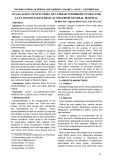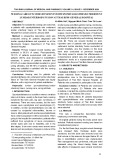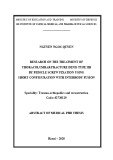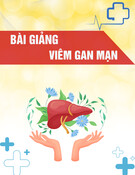
THAI BINH JOURNAL OF MEDICAL AND PHARMACY, VOLUME 14, ISSUE 5 - DECEMBER 2024
67
EVALUATION OF OUTCOMES OF LUMBAR INTERBODY FUSION FOR
L4-L5 SPONDYLOLISTHESIS AT THAI BINH GENERAL HOSPITAL
Vu Minh Hai1*, Nguyen Minh Chau1, Tran Thi Loan1
1. Thai Binh University of Medicine and Pharmacy
*Corresponding author: Vu Minh Hai
Email: haivm75@gmail.com
Received date: 13/11/2024
Revised date: 11/12/2024
Accepted date: 15/12/2024
ABSTRACT
Objective: To evaluate the outcomes of lumbar
interbody fusion surgery for L4-L5 spondylolisthesis
at Thai Binh general hospital from January 2022 to
January 2024.
Method: A retrospective cross-sectional study
was conducted among 68 patients suffered from
L4 - L5 lumbar spondylolisthesis and had operated
at the Neurospine Surgery Department in Thai Binh
general hospital.
Results: The median age of patients undergone
lumbar interbody fusion was 49,5 ± 10 (years
old). Gender ratio was 3 females per 1 male, the
duration of disease detection was 38±18 (months).
Postoperative outcomes verified that lumbar
interbody fusion was the safe and effective surgery
with short operation duration (123,9 ±13,2 minutes),
5,9% of intraoperative adverse incidents, 25% of
short-term postoperative complications, 5,8% of
long-term complications of the surgery. Good and
satisfactory outcomes achieved 86 8% without any
poor outcomes based on Macnab criteria.
Conclusion: lumbar interbody fusion for L4-L5
spondylolisthesis is a safe and highly effective
surgery.
Keywords: lumbar spondylolisthesis,lumbar
interbody fusion, pedicle screw, interbody cage.
I. INTRODUCTION
Spondylolisthesis is the displacement of the
upper vertebrae to lower one. There are many
causes, but the main causes were spondylosis
and spondylolysis [1]. In addition, lumbar
spondylolisthesis can also be caused by congenital
abnomalities, trauma or tumors. Most patients with
lumbar spondylolisthesis have a silent progression
without symptoms. When going to the hospital
for examination, patients often suffered from
symptoms of nerve compression, lumbar spine
pain due to instability, and in the late stages, it can
even cause more severe nerve lesions such as
paralysis, changes in posture of the lumbar spine
and affect gait [2].
Researches in Vietnam demonstrate that
spondylolisthesis usually occurs in the lumbar (low
back) spine, more commonly at L4-L5 (4th and 5th
lumbar vertebral levels) [3-7].
Lumbar interbody fusion surgery is indicated
after nonoperative treatment and rehabilitation
are ineffective for the purpose of nerve root
decompression and vertebral fusion. There are
many surgical methods applied and intensively
studied by many reseachers. Several forein
reseachers have assessed outcomes of lumbar
interbody fusion for L4-L5 spondylolisthesis.
There are only a few reseaches in Vietnam into
this subject, especially at provincial hospitals.
Therefore, we conducted this study to aim at
evaluating the outcomes of lumbar interbody fusion
for L4-L5 spondylolisthesis at Thai Binh general
hospital from January 2022 to January 2024.
II. SUBJECTS AND METHODS
2.1. Subjects
68 patients diagnosed with L4-L5 spondylolisthesis
and undergone lumbar interbody fusion surgery at
Thai Binh general hospital from January 2022 to
January 2024.
2.2. Methods:
Type of reseach: retrospective cross-sectional study
Patient list was created from medical records
of Neurospine Surgery Department (clinical and
radiographic manifestations) before, during and
after treatment
Contact to patients for re-examination (by by
phone and mail). Patients were re-examined with
postoperative radiographs archived were received
questionnaire for data collection. Patients who
could not be contacted were removed from the list.
2.3. Data processing:
Data coding, entry, and analysis were conducted
using SPSS version 22.0. Descriptive statistical
methods were employed to characterize the
dataset, including the calculation of frequencies,
percentages, and mean values. Comparative
analyses between groups were performed using
























